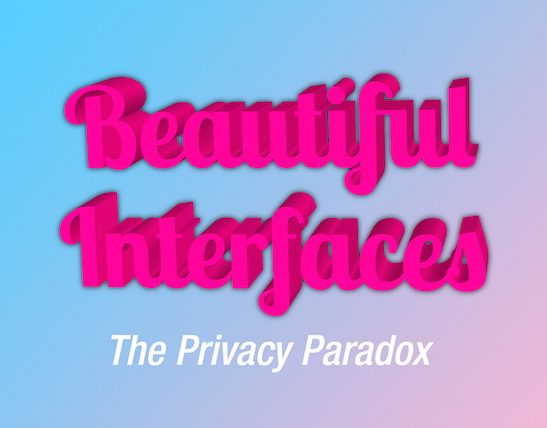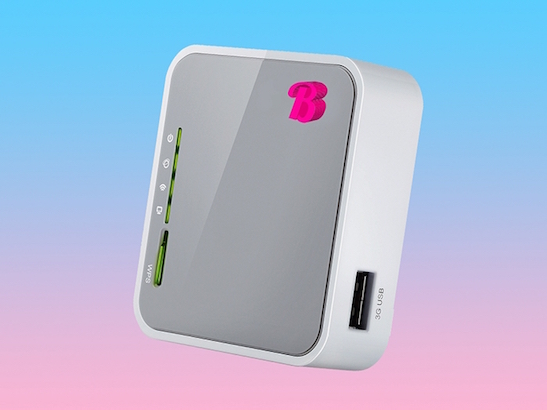BEAUTIFUL INTERFACES: THE PRIVACY PARADOX 4/14-5/14
OPENING THURSDAY, APRIL 14TH, 7PM – 9PM
RSVP REQUIRED
FIREFOX RECOMMENDED – Read instructions to connect
BEAUTIFUL INTERFACES: THE PRIVACY PARADOX is a group show curated by Helena Acosta and Miyö Van Stenis featuring work by Jennifer Lyn Morone, Heather Dewey Hagborg, LaTurbo Avedon, Annie Rose Malamet and Carla Gannis. The exhibited work will live on a wireless network accessible through five routers at the gallery space. The routers have been hacked and are not actually connected to the Internet. Each router has a private network, which visitors must login to through their own devices – cell phones or iPads – to view the artwork. BEAUTIFUL INTERFACES: THE PRIVACY PARADOX explores the dichotomy between the private and the public, creating a platform for distribution of data on an independent and anonymous network.
In the era of algorithm prediction all our online actions have a digital trace, which are used by companies and governments to predict our behaviors. The Internet’s purpose is to collect and quantify each action – becoming a medium for surveillance.
Everyday online social practices could look like harmless actions through a naive eye, but they contain the potential for unexpected consequences when they are traced and connected to algorithmic surveillance systems. In less than five years facial recognition algorithms will be ubiquitous. For example, Facebook has recently added facial recognition technology to their platform, becoming more deeply integrated into our smartphones. These new applications will facilitate easy reconstruction of any random encounter we have on the street that has been captured by a camera.
And even though our increased communication practices on the Social Web result in an increase of personal information online, the ‘Privacy Paradox’* suggests that despite Internet users’ apprehension about privacy, their behaviors do not reflect those concerns. Although we keep insisting on how much we care about our data, the statement ‘privacy is important!’ has become a void belief in our contemporary society.
*In a study into the matter of The Privacy Paradox, researchers created two fictitious online shops. One of the shops demanded less personal data from their customers, but the DVDs on sale cost one euro more than in the second shop, which wanted to know a lot more about its customers. Almost all users picked the cheaper store. Even when the prices were the same in both shops, only half of the subjects chose the privacy-friendly variety. Apparently, we are not willing to pay a price for privacy. The costs of privacy are virtually zero.
Monika Taddicken, Institute of Journalism and Communication Research (Hamburg, Germany: University of Hamburg).
A router is a networking device that forwards data packets between computer networks. Routers perform the “traffic directing” functions on the Internet. By hacking them, the exhibition is reinforcing this idea of the privacy paradox, erasing the router’s predetermined function and transforming it into a device that offers a private experience. The hacking process of this exhibition is powered by Occupy.here an open source project developed by Dan Phiffer in 2011.
Annie Rose Malamet’s ‘Hooker Meditation Exercise’ is a video art piece that examines anonymity, fear, and visibility in relation to sex work. Malamet uses her own advertisements, client voicemails, and original footage to create a narrative about the anxiety of being discovered and to reflect on her own identity.
In ‘Electronic Graveyard No.2’ Carla Gannis explores the collision of traditional self portraiture in fine art and social media’s selfie culture. Gannis creates a distopic futuristic Graveyard where digital identity and daily online practices live forever on the collective memory of the social web; where even after we are dead, our privacy can still be exposed.
Heather Dewey Hagborg works at the intersection of art and science, placing an emphasis on conceptions of the natural and the artificial. ‘Stranger Visions’ is a series of portrait sculptures created from genetic material collected in public places by the artist. Working with the traces strangers unwittingly leave behind, Dewey Hagborg calls attention to the developing technology of forensic DNA phenotyping and the potential for a culture of biological surveillance.
Jennifer Lyn Morone affirms “I am a data slave and so are you.” Morone uses ethics and economic reasoning to create a business model, where she is the corporation that owns her own data. Jennifer Lyn Morone™ Inc is a hyper capitalistic model, where Morone over exposes her data in order to protect and capitalize it. For the exhibition, the curators have selected to show Jennifer’s data from their first contact with her up until the moment of the exhibition.
In ‘ID,’ LaTurbo Avedon visualizes the attributes that she has acquired in virtual space. Using data like facial detection markers and her lifted fingerprints, she reveals the process of creating personal metadata for the identification of a digital self.
BEAUTIFUL INTERFACES: THE PRIVACY PARADOX will open on Thursday, April 14th from 7pm – 9pm at REVERSE. As space is limited, RSVP is required for the event. RSVP here, and remember to bring your fully charged devices and headphones to the opening. BEAUTIFUL INTERFACES: THE PRIVACY PARADOX will be on view through May 14th. The project space will be open Tuesdays and Thursdays from 1pm – 7pm and for extra gallery hours Friday, April 15th and Saturday, April 16th from 2pm – 7pm. The curator Helena Acosta will be at the space at this time to talk about the exhibition.
As part of the programming activities for the exhibition, REVERSE will host a panel discussion at Creative Tech Week on May 4th, Post Privacy: Is privacy becoming a thing of the past?.
Downloadable PDF

INSTRUCTIONS:
1. Install FireFox Browser on your mobile device. BEAUTIFUL INTERFACES is an exhibition hosted in an OpenWrt router. The interface works better using Firefox, however if you use Android you can use the default browser of the operating system called Internet.
2. Open your Wi-Fi preferences on your mobile device.
3. Select one of the 5 private networks named:
BI/ Carla Gannis
BI/ Heather Dewey-Hagborg
BI/ Annie Rose Malamet
BI/ LaTurbo Avedon
BI/ Jeniffer Lyn Morone
4. If the page doesn’t open automatically, open Firefox and type http://beautiful.interfaces or http://beautiful.interfaces/privacyparadox (to go directly to the HOME page) or scan the QR code provided at the exhibition.
5. Welcome! You’re connected to the network of BEAUTIFUL INTERFACES. Click below the title to visualize the artist’s work of the network you selected.
6. Navigate through the exhibition with the Menu.
7. To visualize a different artist, go to your Wi-Fi preferences and change the network. Please make sure you close the browser app to reset the session information.
8. Go back to the HOME page of the exhibition interface and enjoy the new artist.



